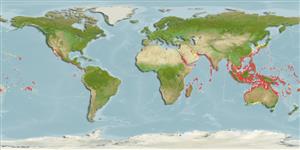Common names from other countries
Classification / Names / Names
Namen | Synonyme | Catalog of Fishes (gen., sp.) | ITIS | CoL | WoRMS
Environment: milieu / climate zone / depth range / distribution range
Ökologie
; tiefenbereich 0 - 35 m (Ref. 348), usually 0 - 35 m (Ref. 75831). Tropical
Indo-West Pacific: from East Africa and the Red Sea to Fiji Islands; north to southern Japan and south to northern Queensland and Western Australia.
Length at first maturity / Size / Gewicht / Alter
Maturity: Lm ? range ? - ? cm Max length : 30.0 cm SHL Männchen/unbestimmt; (Ref. 348); common length : 20.0 cm SHL Männchen/unbestimmt; (Ref. 348)
Shell solid, reaching a very large size, obliquely ovate in outline, with posterior ear drawn out into a narrow, more or less elongated, wing-like expansion; slightly inequivalve, left valve a little more inflated and with a weak rounded fold radiating from umbo to posteroventral end of shell. Outline of shell variable, initially narrowly oblique, later greatly expanding ventrally and almost as high as long, or even higher than long in larger specimens and with the posterior ear relatively short. Interior of shell with a wide non-nacreous margin ventrally. Colour: outside of shell plain dark brown to black. Interior silvery and brilliantly nacreous, with a broad, posteroventrally expanded, glossy black margin.
Found in intertidal areas on rocks (Ref. 75831). Sometimes attached to sea whips (Ref. 799). Also found subtidal, on dead coral heads (Ref. 75840).
Life cycle and mating behavior
Geschlechtsreife | Fortpflanzung | Ablaichen | Eier | Fecundity | Larven
Members of the class Bivalvia are mostly gonochoric, some are protandric hermaphrodites. Life cycle: Embryos develop into free-swimming trocophore larvae, succeeded by the bivalve veliger, resembling a miniature clam.
SAUP Database. 2006. (Ref. 356)
IUCN Rote Liste Status (Ref. 130435)
CITES Status (Ref. 108899)
Not Evaluated
Not Evaluated
Nutzung durch Menschen
Fischereien: kommerziell
FAO - Aquakultur: production; | FishSource | Sea Around Us
Tools
Internet Quellen
Estimates based on models
Preferred temperature
(Ref.
115969): 24.2 - 29.1, mean 28 (based on 2122 cells).
Verwundbarkeit
Low vulnerability (20 of 100).
Preiskategorie
Unknown.
